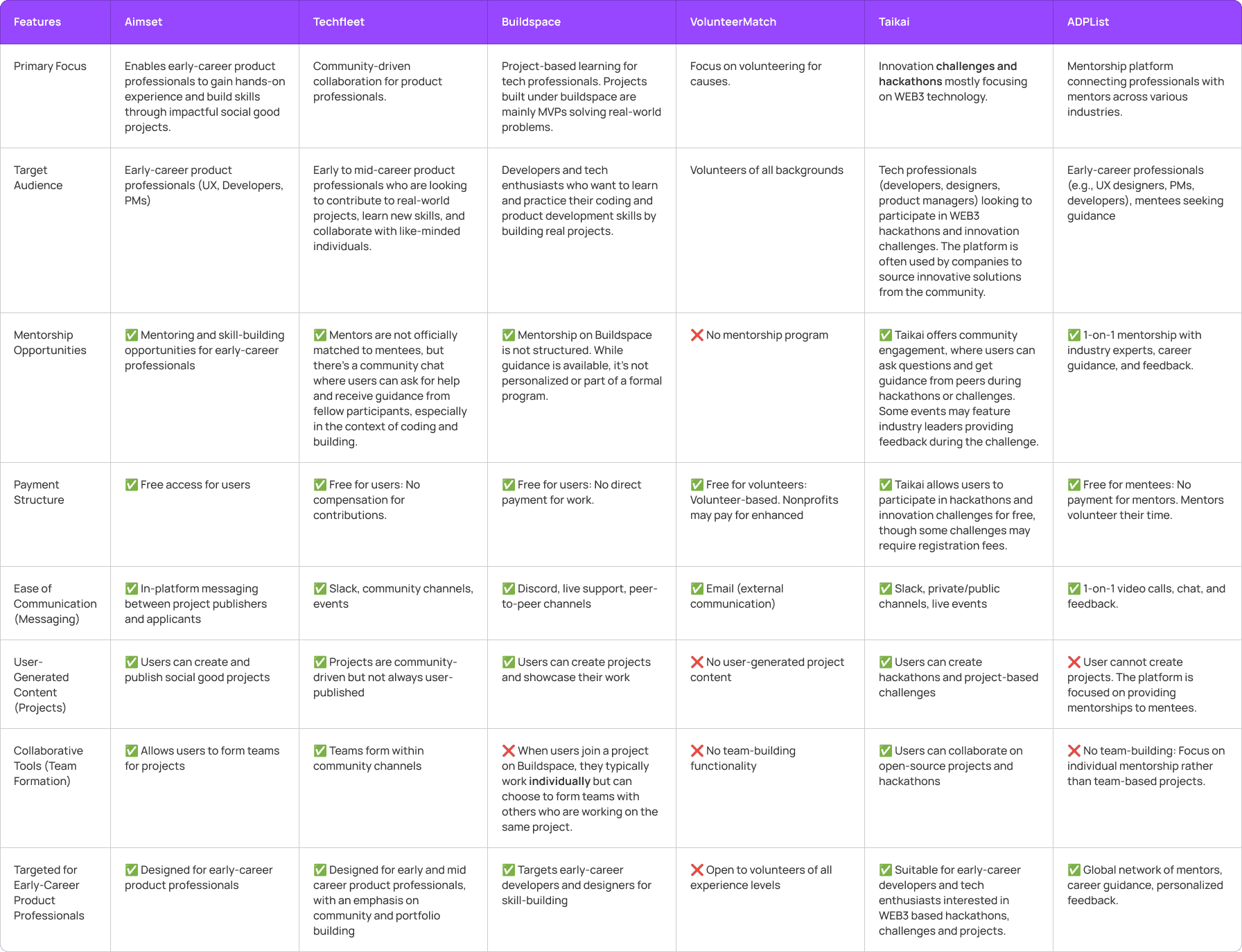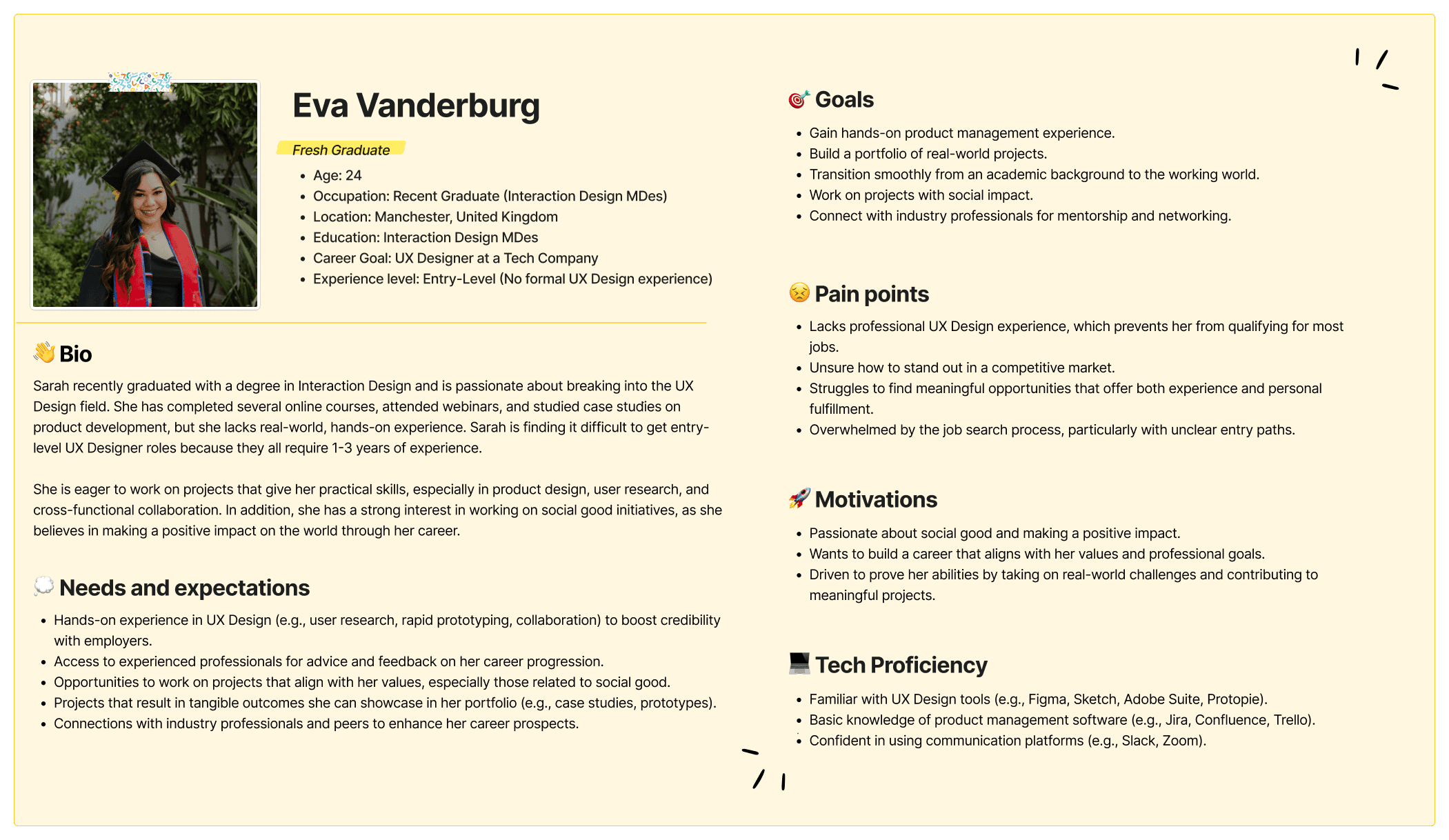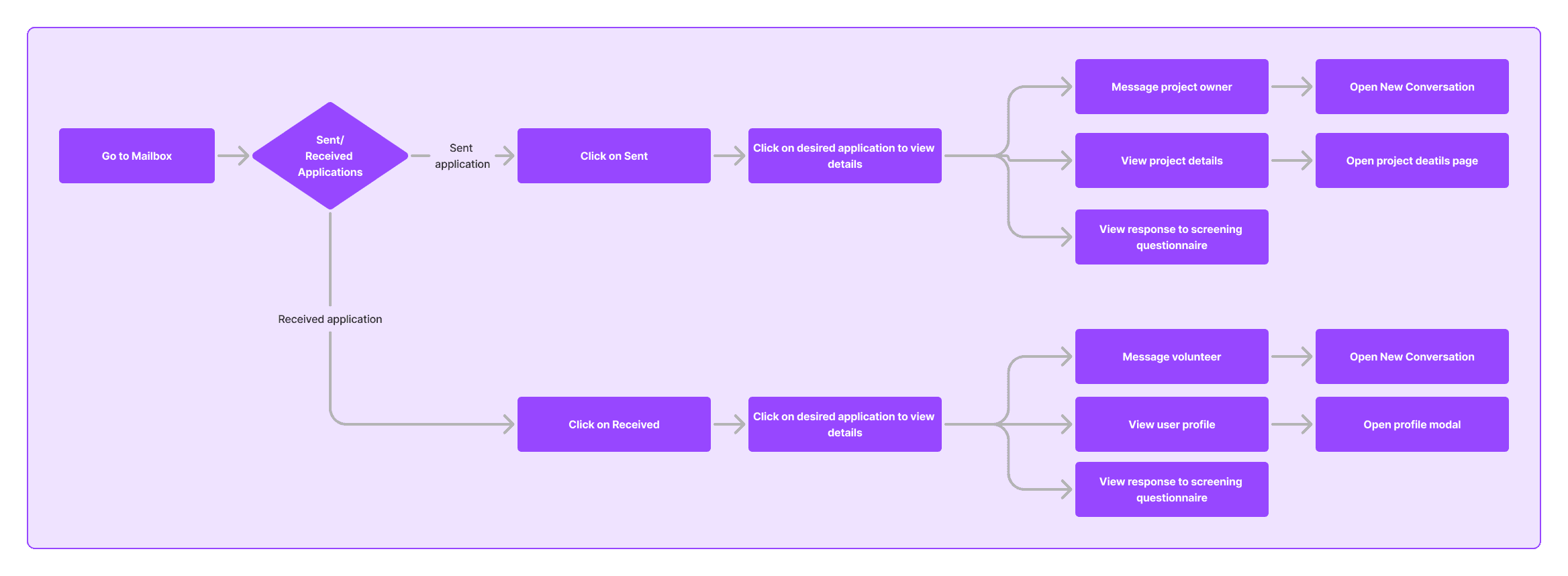Aimset
A platform that was designed to help early-career product professionals gain hands-on experience by contributing to social good projects. The platform allowed users to post projects, volunteer for projects, and collaborate with others, all while developing practical skills and building their professional portfolios.
Duration
9 months
Year
2024
Tools used
Miro
Jira
FigJam
Figma
Maze
Role
Product Designer
Responsibilities
Competitor Analysis
User Requirement Prioritisation
Persona Development
Information Architecture
Userflows
UI Design
Prototyping
Usability Testing
Before I joined the team, the initial research phase had already been completed, with user interviews and surveys conducted to understand the pain points of early-career product professionals to form a problem statement.
🎯The Problem Statement
Early-career product professionals struggle to find opportunities to gain hands-on experience and showcase their skills, especially in projects that contribute to social good.
They also lack access to structured mentorship and collaborative environments.
Overall Process
Ideation
Competitor Analysis
Unique Value Proposition
Define
User Requirement Prioritisation [Impact-Effort Matrix]
User Persona Development
Design
Information Architecture
User flows
Prototyping
Deliver
Usability Testing
Next Steps…
Ideation
Competitor Analysis
To understand the competitive landscape, I analyzed other platforms offering similar services (like mentoring, hands-on projects, social-good projects and team collaboration) for early career product professionals or volunteer opportunities. This helped us identify gaps and create a unique value propositions for Aimset:
💡 Unique Value Proposition
Empowering early-career product professionals to gain practical experience, develop mentorship relationships, and build impactful portfolios by connecting them with collaborative social good projects.
Define
User Requirement Prioritisation
I led the user requirement prioritization for Aimset’s MVP using the Impact-Effort Matrix, collaborating with the team to evaluate each feature’s value and feasibility.
Features considered for the first iteration of the MVP:
🟢 Quick Wins:
Onboarding (Sign-up):
Essential for users to start using the platform.
Login
Critical for returning users to access their account and platform features.
Create Project
Core feature for project creators to initiate social good initiatives.
Messaging Feature
Facilitates communication between project creators and volunteers, improving user engagement.
Project Details Page
Essential for volunteers to understand project details before applying.
Applications History
Important for users to track their application status but can be added after the main features are live.
🟣 Major Project:
Project Listing (Dashboard)
Vital for volunteers to browse and filter available projects based on interests, skills, and tags.
Persona Development
I created user personas to better understand our target users' needs, goals, and pain points: early-career product professionals seeking to gain practical experience through social good projects.
I used insights from initial user research - surveys and interviews, to identify patterns in user behaviours and motivations.
Design
Information Architecture
Due to time constraints and the product's development phase, we recruited four participants for a card sorting activity. Insights from this exercise informed decisions in developing the Information Architecture (IA).
The team brainstormed to determine the necessary forms and input data, grouping related features and information together.
I created the Information Architecture (IA) to map and organize the prioritized features for the MVP, focusing on key user requirements such as project creation, volunteer applications, and messaging based on card sorting activity that was performed with users.
User flows
I developed user flows that elaborated on the start-to-end steps taken by the users for core tasks on the platform along, such as:
Creating a project
Applying to a project
Tracking Applications & messaging volunteer or project publisher
Prototype
A prototype was designed using Figma to assist design-developer hand-off and also to perform usability test to save iteration time wherever possible. I mainly contributed to the design system and design and prototyping of Project Creation, Project Application and Profile view flows.
Project Creation: Share your Idea, Inspire action
Visual Thumbnails
Quickly convey the project’s focus and make the page easier to scan without reading everything.
Clear Structure
A well-defined project name, overview, and goals help volunteers instantly assess if they align with the project’s mission.
Targeted Information
Specific role descriptions, technologies, and commitment details ensure volunteers know exactly how they can contribute.
Volunteer applications: Find your perfect match for social good
Role Selection
Ensures volunteers apply for the right role in multi-role projects, streamlining the application process.
Motivation & Commitment
Captures why volunteers are interested and how many hours they can contribute, aligning expectations and enthusiasm.
Open Communication
Provides space for questions or additional comments, fostering clarity between volunteers and project publishers.
Volunteer profile access: Know your volunteers
Personal Details, Social Media, and Interests
The profile includes personal information, social media links, a brief about section, and areas of interest, giving project publishers a holistic view of the volunteer’s background and preferences.
Skills and Technical Competencies
Volunteers can showcase their core skills and technical proficiencies, enabling publishers to quickly assess the relevance of their expertise for the project.
Proof of Work
Including a CV or portfolio allows publishers to review the volunteer’s past work and determine if their experience aligns with the project’s requirements.
Usability Testing
Usability Testing
Impact
250+
Members signed-up
20
Projects Created
250+
Members Onboarded
Next Steps
While Aimset was ultimately sunsetted due to financial constraints, its impact during its operational period was significant. The platform facilitated numerous collaborations on social good projects, providing early-career product professionals with valuable hands-on experience.
In reflecting on Aimset's journey, several key insights have emerged:
Sustainable Business Model:
Future initiatives should consider integrating monetization strategies early in the development phase to ensure financial sustainability.
Community Engagement
Building and maintaining an active user community is crucial. Implementing features that encourage ongoing interaction and contribution can enhance user retention and platform vitality.
Scalability
Designing platforms with scalability in mind allows for growth and adaptation to increasing user demands and evolving market conditions.
These lessons will inform the development of future projects, ensuring they are better equipped to meet user needs and achieve long-term success.









